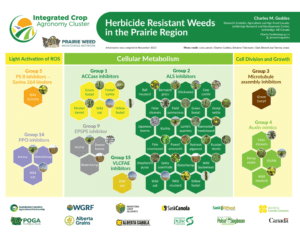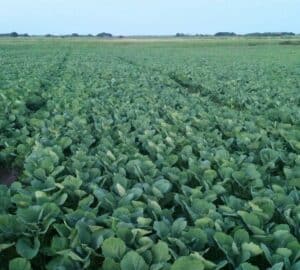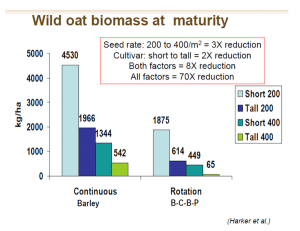Herbicide-resistant (HR) weeds are common across the Prairies and have created management challenges on some farms. Noteworthy on the long list of HR weeds are Group-9 resistant kochia, found anywhere, and Group-9 resistant downy brome, which was detected in southern Alberta in 2021. Many HR weed populations are resistant to more than one herbicide group. Farms relying almost exclusively on herbicides to manage weeds may want to consider a more integrated approach to take the pressure off herbicides.

This article describes integrated weed management (IWM) tools that, when combined, keep weeds from adapting to or becoming resistant to any one practice.
IWM practices fit into three groups:
1. Make the crop more competitive

Hugh Beckie and Neil Harker, former AAFC research scientists who wrote Our top 10 herbicide resistant weed management practices, call this the “first up wins” approach. Use the following steps to improve crop competition:
Higher seeding rates
Higher plant populations allow the crop to shade weeds and make it more difficult for weeds to access nutrients and water. Canola crops that close the canopy quickly may only require one in-crop herbicide spray compared to less dense (thin) crops, which may require two applications. In most cases, seeding rates can be moderately increased to obtain weed management benefits without significant negative consequences.
Varied seeding dates
Early-seeded canola can result in the crop emerging before the weeds. Some weeds, like green foxtail, lamb’s-quarters, kochia, redroot pigweed and Russian thistle, require more growing degree days to germinate and emerge. An early-seeded canola crop could emerge far enough ahead of these weeds that herbicides may not be required. However, cool season weeds like wild oats, quackgrass, wild mustard and stinkweed may present a problem with early seeding. Later seeding may be used to give more time for pre-seed burnoff, and it make for a faster-emerging more competitive crop. More to come on this, once the Updating the critical weed free period in canola project gets underway this spring.
Shallow seeding depth
Seeding at one to 2.5 centimetres (half to one inch), provided adequate moisture is present, means quicker seedling emergence. This helps the crop get ahead of or keep up with the weeds. Deep seeding delays crop emergence and weakens seedlings, making them less competitive.
Narrow row spacing
Fast ground cover makes canola, or any crop, more competitive. Canola in 8″ rows will cover the ground faster than canola in 15″ rows. Narrow rows also help with higher seed rates, another key crop competition tactic. Higher seeding rates with wider rows causes more in-row competition between crop plants, reducing the return on investment for seed.
Taller crops
Taller crops tend to be more competitive. In a study by Neil Harker, taller crops had less the half the wild oat biomass that shorter crops had. (See the graphic.)
Fertilizer placement
Fertilizer placed near the seed row and below the seed row tends to be more accessible to the crop, and less accessible to weeds. Broadcast fertilizer is equally accessible to crop and weeds. Weeds are typically better at scavenging nutrients than crops, so when access is equal, the crop loses.
Seed treatment
Seed treatments reduce seedling diseases, allowing plants to be stronger and therefore more competitive with weeds. Protection from insects such as the flea beetle also enhances seedling vigour.

2. Keep weeds off balance
A steady routine selects for weeds that thrive under that routine. You don’t want weeds to adapt to your routine. Use the following steps to keep weeds off balance.
Take a whole rotation approach
A diverse crop rotation allows for different in-crop herbicide options. Include crops that are more competitive, grow taller, have winter or perennial seasons, or varying harvest times to provide more competition against weeds. Fall rye and winter wheat, for example, offer more spring competition because they are filled in and established before weeds germinate in the spring. They are also combined early, preventing maturing weeds from setting seed.
Competitive crops may have more biomass and early-season vigour, blocking sun from later-emerging weeds. For grassy weeds, for example, avoid back-to-back cereals on the same field and use canola to offer non-selective herbicides like glyphosate or glufosinate. More vigorous canola hybrids sown at a higher plant population are very competitive and result in reduced weed growth and lower dockage. Learn more in this mitigating herbicide resistance summary.
Tank-mix herbicides from different groups
Tank mixes are effective only if the provide two or more active ingredients that are “effective” on the target weed(s). For example, if a weed is resistant to (or not controlled by) a Group 2 herbicide, a tank mix of Group 2 and Group 9 is not an effective multi-mode of action tank mix to control that weed. “Effective” is the key word. Hitting weeds with two modes of action effective on each weed reduces the risk of herbicide resistant weeds escaping and setting seed.
Avoid back to back in-crop applications of the same herbicide group. (A note from Clark Brenzil, Saskatchewan weed management specialist, on Group 1 herbicides: There are about five or six different single gene mutations that impart resistance to Group 1 herbicides. Each has its own cross section of groups such that almost all will impart HR to “-fops”, about half will impart HR to the older “-dims” and one will impart HR to each of pinoxaden or clethodim. If a population of weeds is known to be Group 1 “fop” resistant, ideally the farmer would switch to an entirely different Group to manage those weeds – unless the farmer had no other choice for grass control (ie. Flax). In that situation, the farmer might try a different Group 1 (not a “fop”).)
Consider strategic tillage
No-till is a valuable practice on the Canadian Prairies, and it depends on effective herbicides. In some cases, spot tillage or strategic tillage may be required to protect the usefulness of those herbicides essential to a no-till or reduced-tillage system.
Spring tillage
Spring tillage to control weeds can further dry out the seedbed. In moist conditions, it can create clods in heavier soils, which reduces seed to soil contact and hurts canola emergence. However, spring tillage allows for stubble to stand throughout the fall and winter, which reduces erosion and traps more snow. Spring tillage done after the first flush of annuals emerge can provide a non-herbicide alternative for perennial, winter annual and annuals. Seeding soon after may reduce the need for in-crop applications.
Fall tillage
Fall tillage ahead of canola crops reduces the stubble stand that traps snow and reduces soil erosion. However fall timing provides mechanical weed control while giving the soil time to resettle, allowing for improved seed placement and seed to soil contact the following spring. Some fall tillage considerations are listed below:
- Shallow cultivation in the fall, resulting in a light soil covering of weed seeds, is the most effective means of stimulating annual weed germination, including wild oats and volunteer canola. Harrowing is relatively ineffective as it does not provide a sufficient soil cover to favour germination.
- Deeper tillage penetration may be required to destroy roots of perennial weeds such as Canada thistle and quackgrass. Deeper tillage may also be required to prepare the soil for soil-incorporated herbicides or fertilizers, and to bury some of the straw.
- Deep fall tillage buries weed seeds deeper and induces dormancy in wild oats and other smaller weed seeds. Small weed seeds with a long dormancy period (wild mustard and stinkweed) most readily lose dormancy when left on the soil surface. Deep fall tillage can also induce dormancy in volunteer canola.
- Fall spraying is more effective than tillage for winter annuals like stinkweed, flixweed, tansy mustard, groundsel, and winter annual cleavers, which do not germinate until late September or October. These weeds germinate, establish a root system and form a rosette that is not killed by winter frosts. The plants overwinter and continue to grow as soon as snow disappears in the spring. By the time fields can be worked in the spring, these weeds have often become well-established and hard to kill, requiring extra tillage that dries out the seedbed. These weeds can be more effectively controlled by late fall spraying than with tillage. Tillage often transplants the weeds, allowing them to grow.
3. Prevent weed problems before they start
These practices help “clean up” the farm to keep weed seed banks in check.
Scout each field before and after herbicide application
A pre-application scout will identify the weeds present and their stage. This will determine what tank mix to use, and the herbicide rate required. Scouting will also help to decide whether a spray is needed. Consider a different approach for each field, as necessary. Two weeks after spraying, check the field again to identify escapes or next flushes. What weeds are not controlled, and why? If escapes are in a small patch, spot spraying, mowing or hand weeding may be the best way to get rid of them before they set seed. Immediate and thorough removal of the patch is highly recommended if these weeds are potentially herbicide resistant.
Escapes have a number of potential causes:
- The sprayer missed a patch. (Does the patch include many species of weeds and have a shape like a sprayer miss?)
- The herbicide applied has limited activity on a particular weed. (Double-check the weeds on the product label.)
- Herbicide rates and/or water volumes were too low to provide control on a particular weed. (In this case, you may have these weeds showing up all across a field.)
- Weeds were already too large for label rates. (Escapes may show some leaf damage but not enough to kill the plant.)
- Weeds emerged after the herbicide application. (Are escapes small enough for this to make sense?)
- Weeds are resistant. (Were some of those weeds killed but an odd-shaped patch or a few random weeds were not? This could be a clue.) Labs that test for herbicide resistance.
Keep records
What weeds are in each field? What products were sprayed and other techniques used? Keep track of agronomy practices that may influence weed management and crop competition. Use this information to make a weed management plan for each field that addresses the weeds present and their characteristics.
Take steps to improve herbicide efficacy
Follow herbicide labels for timing, rates and water volumes as well as weather restrictions (frost, rain, heat) that may reduce efficacy. Cutting rates, for example, may reduce herbicide efficacy and increase weed seed return to the soil seed bank. Early control is an important step, as herbicides are more effective on small weeds. Finally, water quality can influence efficacy for some herbicides, including glyphosate, glufosinate, 2,4-D amine and Group 1 “-dim” herbicides. Water hardness reduces glyphosate, glufosinate and 2,4-D amine efficacy. The recommendation is to test water and find another water source for glyphosate if hardness exceeds 40 grains/US gallon total hardness (700 ppm CaCO3 equivalent).
The “best” configuration of low boom height, slow travel speed and coarser spray was only somewhat more uniform compared to the alternative of higher boom height, faster travel speed and finer spray in Tom Wolf’s Characterizing turbulent spray deposition from self-propelled sprayers study.
Use sanitation to slow weed spread
This includes a few useful practices:
- Clean farm equipment, especially combines, between fields, especially after combining fields with problem weeds.
- Manure can spread a lot weeds. Proper rotting or composting can kill the weeds.
- Mow ditches and spray field edges to prevent large weed populations from setting seed
- Use certified seed. It has tight standards for non-crop seeds.
- Tarp grain loads. Lighter weeds are often rise to the top and can blow out of the truck in transit.
Invest in harvest weed seed control
The goal of harvest weed seed control is to prevent the return of weed seeds to the soil seed bank, where they can perpetuate the population. Harvest weed seed control can also prevent the combine from spreading resistant weed biotypes around the field. Look at harvest time options to manage weed seeds. Methods include:
- collecting weeds with chaff carts
- direct-harvest crop
- residue baling
- narrow-windrow burning
- seed pulverization with integrated impact mills (This article describes the options.)
The system best adapted in preventing the spread of herbicide resistant weeds is the integrated impact mill, where 95 to 99 per cent of weeds entering the combine are destroyed or made non-viable from impacts. While the initial price of these systems may seem prohibitive, when averaged across several seasons of use, they can be less costly than soil-applied herbicides.
More
- Canola Digest article on harvest weed seed destroyers
- Manage Resistance Now website. (It includes a page on glyphosate-resistant kochia.)
- HR weed management video from Canolapalooza (Real Agriculture)
- Canola Digest article on optical spray systems
- WGRF has a summary of “Our top 10 herbicide-resistant weed management practices” by Hugh Beckie and Neil Harker. The full report is in Pest Management Science, Volume 73, June 2017.
- Weed management projects on the Canola Research Hub
